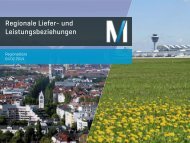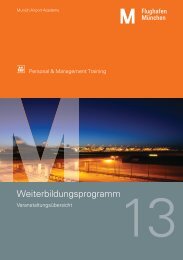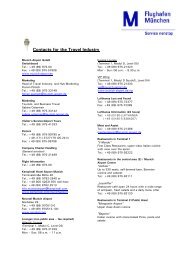"Perspectives 2011" - Sustainability and Annual Report (pdf)
"Perspectives 2011" - Sustainability and Annual Report (pdf)
"Perspectives 2011" - Sustainability and Annual Report (pdf)
You also want an ePaper? Increase the reach of your titles
YUMPU automatically turns print PDFs into web optimized ePapers that Google loves.
Introduction Company profile <strong>and</strong> strategyService portfolio Communication <strong>and</strong> social responsibilityClimate strategy) See p. 37 f. <strong>and</strong> p. 108) Glossary) Glossary) Glossary) www.munich-airport.com/climate-protection) Glossary) See p. 41Action at multiple levelsClimate change involves everyone, <strong>and</strong> at Munich Airportwe are keenly aware of our responsibility whenit comes to reducing our climate footprint. This is whywe engage in a comprehensive array of initiatives tomitigate <strong>and</strong> offset our climate impacts.Members of the ) German Airports Association(ADV) have defined an extensive climate strategy thatsystematically charts a way forward for Germany’scommercial airports. Intended to complement the fourpillarapproach originally adopted by the aviation industryin Germany in 2007, the ADV’s climate strategy in -volves carefully logging ) emissions <strong>and</strong> taking concreteaction to bring about their reduction. The formerfour-pillar approach set out to minimize aviation’s en -vironmental impacts through new technologies, effi -cient infrastructure, optimized operations <strong>and</strong> economicinstruments, while at the same time enablingthe industry to grow <strong>and</strong> remain competitive.In July 2008, the European Parliament proposed a capon aircraft carbon dioxide emissions, setting as theupper limit the mean ) CO 2 emissions generated byair transport between 2004 <strong>and</strong> 2006. From 2012, airlines’emissions must not exceed 97 percent of thisguideline figure, <strong>and</strong> 95 percent from 2013.Our contribution to climate protectionOur scope for exerting a positive influence on climatechange may be limited, but we explore every possibleavenue to bring down emissions as far as we can. Partof our strategy is to manage our airport’s operations<strong>and</strong> development in such a way that we contain <strong>and</strong>control our impacts on the environment effectively <strong>and</strong>do more than merely comply with statutory requirements<strong>and</strong> environmental regulations.Preserving resources, saving energy <strong>and</strong> reducing car -bon emissions are three core targets when we planour buildings, a policy evidenced by the ) satellitewe are constructing for Terminal 2. We use the latestenergy provisioning technology available, we systematicallyexploit potential savings through smartenergy-management solutions, <strong>and</strong> we take stepsto promote employee awareness of the importanceof using energy sustainably. We also protect the l<strong>and</strong><strong>and</strong> preserve natural diversity by working closely withthe nature conservation authorities to plan suitable) compensatory mitigation measures.One of our most ambitious targets is to achieve carbon-neutralgrowth by 2020. Essentially, this meanskeeping the carbon emissions that we as an organizationcan directly control to a level of around 160,000tons a year (the volume in 2005, our baseline year), inspite of our expansion plans <strong>and</strong> our projected trafficgrowth. Without systematic efforts to control our carbonfootprint, our emissions would likely increase bybetween 50,000 <strong>and</strong> 80,000 tons by 2020.To hit our target, we launched a group-wide carbonreduction program in 2009. It has four main thrusts:sustainable energy provisioning, efficient use of ener -gy, awareness-raising among our workforce, <strong>and</strong> sustainablebuilding. You can find additional informationon our climate initiatives on the ) Internet.Systematic CO 2 monitoring <strong>and</strong> footprintanalysisA key element in carbon management is our carbondatabase, developed in-house at FMG, which providesus with a reporting, control <strong>and</strong> tracking tool forall our activities relating to carbon reduction <strong>and</strong> energyeffi ciency. We first published details of our carbonfoot print in 2008. This was prepared in line with theinternationally acknowledged ) Greenhouse GasProtocol (GHG Protocol), which groups emissions bysources into three so-called scopes.Scope 1 consists of direct emissions caused by ourown energy production; scope 2 covers indirect94
















